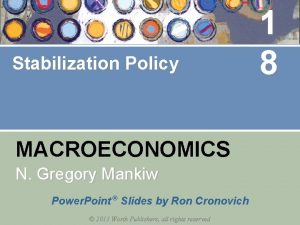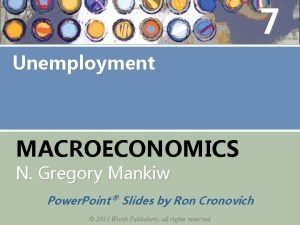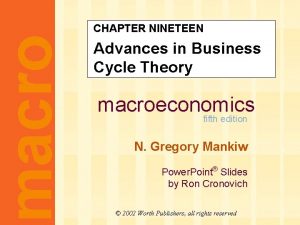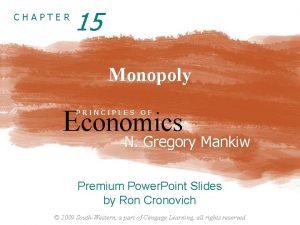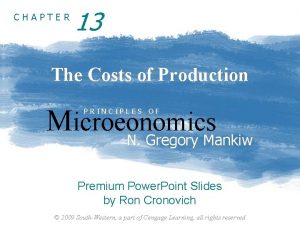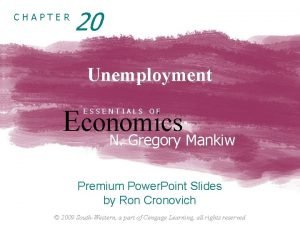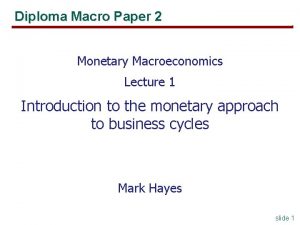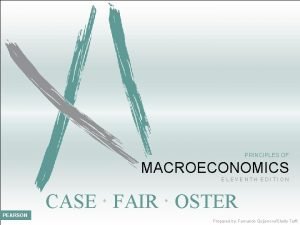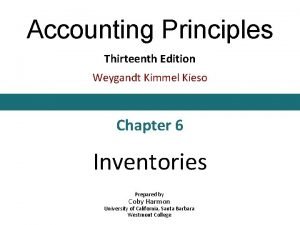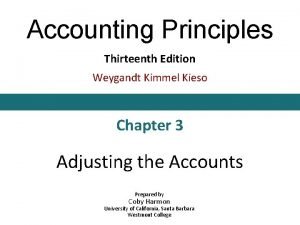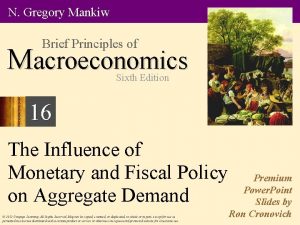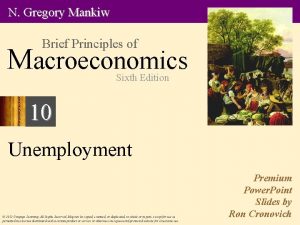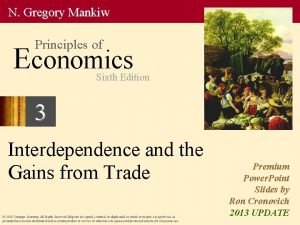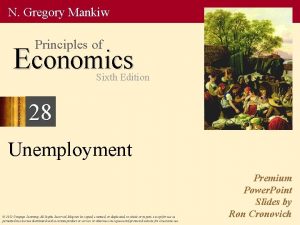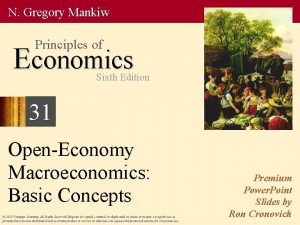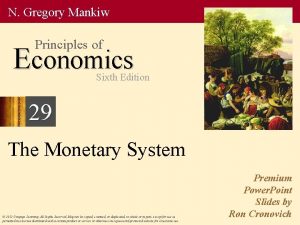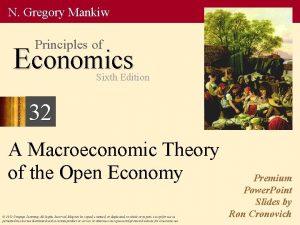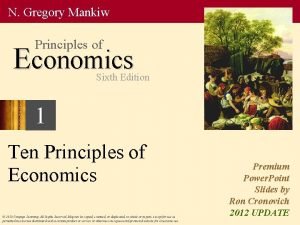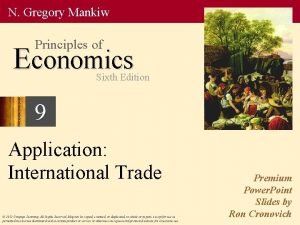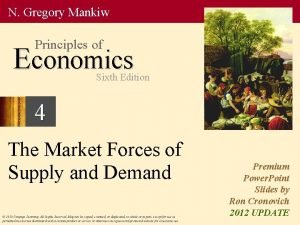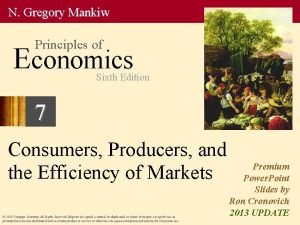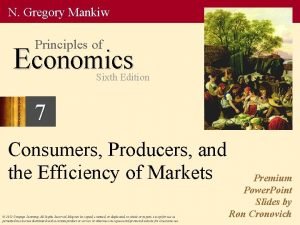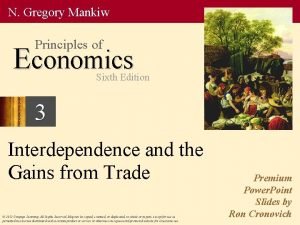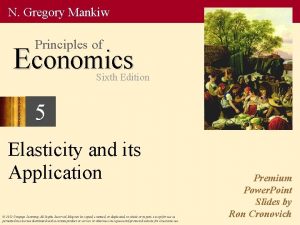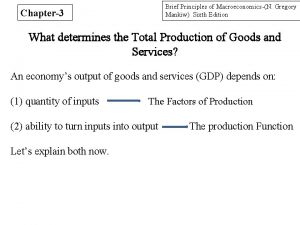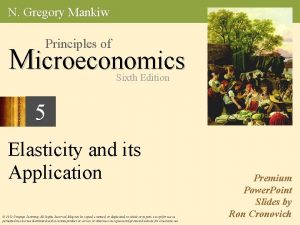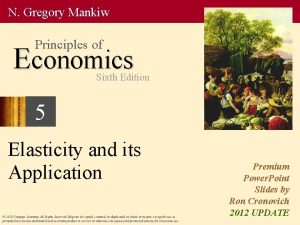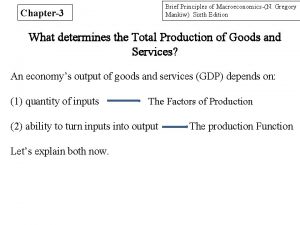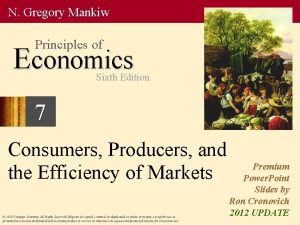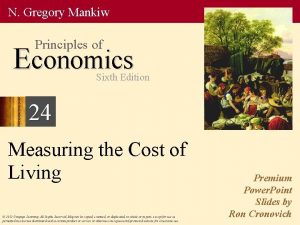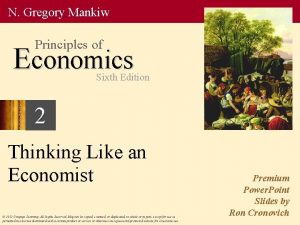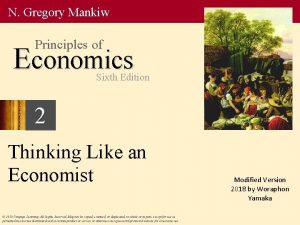N Gregory Mankiw Principles of Macroeconomics Sixth Edition















































- Slides: 47

N. Gregory Mankiw Principles of Macroeconomics Sixth Edition 7 Consumers, Producers, and the Efficiency of Markets © 2014 Cengage Learning. All Rights Reserved. May not be copied, scanned, or duplicated, in whole or in part, except for use as permitted in a license distributed with a certain product or service or otherwise on a password-protected website for classroom use. Premium Power. Point Slides by Ron Cronovich 2013 UPDATE

In this chapter, look for the answers to these questions: • What is consumer surplus? How is it related to the demand curve? • What is producer surplus? How is it related to the supply curve? • Do markets produce a desirable allocation of resources? Or could the market outcome be improved upon? © 2014 Cengage Learning. All Rights Reserved. May not be copied, scanned, or duplicated, in whole or in part, except for use as permitted in a license distributed with a certain product or service or otherwise on a password-protected website for classroom use. 1

Welfare Economics § Recall, the allocation of resources refers to: § how much of each good is produced § which producers produce it § which consumers consume it § Welfare economics studies how the allocation of resources affects economic well-being. § First, we look at the well-being of consumers. © 2014 Cengage Learning. All Rights Reserved. May not be copied, scanned, or duplicated, in whole or in part, except for use as permitted in a license distributed with a certain product or service or otherwise on a password-protected website for classroom use. 2

Willingness to Pay (WTP) A buyer’s willingness to pay for a good is the maximum amount the buyer will pay for that good. WTP measures how much the buyer values the good. name WTP Anthony $250 Chad 175 Flea 300 John 125 Example: 4 buyers’ WTP for an i. Pod © 2014 Cengage Learning. All Rights Reserved. May not be copied, scanned, or duplicated, in whole or in part, except for use as permitted in a license distributed with a certain product or service or otherwise on a password-protected website for classroom use. 3

WTP and the Demand Curve Q: If price of i. Pod is $200, who will buy an i. Pod, and what is quantity demanded? A: Anthony & Flea will buy an i. Pod, Chad & John will not. name WTP Anthony $250 Chad 175 Flea 300 John 125 Hence, Qd = 2 when P = $200. © 2014 Cengage Learning. All Rights Reserved. May not be copied, scanned, or duplicated, in whole or in part, except for use as permitted in a license distributed with a certain product or service or otherwise on a password-protected website for classroom use. 4

WTP and the Demand Curve Derive the demand schedule: P (price of i. Pod) who buys Qd $301 & up nobody 0 251 – 300 Flea 1 Anthony $250 176 – 250 Anthony, Flea 2 Chad 175 Flea 300 Chad, Anthony, 126 – 175 Flea 3 John 125 John, Chad, 0 – 125 Anthony, Flea 4 name WTP © 2014 Cengage Learning. All Rights Reserved. May not be copied, scanned, or duplicated, in whole or in part, except for use as permitted in a license distributed with a certain product or service or otherwise on a password-protected website for classroom use. 5

WTP and the Demand Curve P Q © 2014 Cengage Learning. All Rights Reserved. May not be copied, scanned, or duplicated, in whole or in part, except for use as permitted in a license distributed with a certain product or service or otherwise on a password-protected website for classroom use. P Qd $301 & up 0 251 – 300 1 176 – 250 2 126 – 175 3 0 – 125 4 6

About the Staircase Shape… P This D curve looks like a staircase with 4 steps – one per buyer. If there were a huge # of buyers, as in a competitive market, there would be a huge # of very tiny steps, and it would look more like a smooth curve. Q © 2014 Cengage Learning. All Rights Reserved. May not be copied, scanned, or duplicated, in whole or in part, except for use as permitted in a license distributed with a certain product or service or otherwise on a password-protected website for classroom use. 7

WTP and the Demand Curve P Flea’s WTP Anthony’s WTP Chad’s WTP John’s WTP At any Q, the height of the D curve is the WTP of the marginal buyer, the buyer who would leave the market if P were any higher. Q © 2014 Cengage Learning. All Rights Reserved. May not be copied, scanned, or duplicated, in whole or in part, except for use as permitted in a license distributed with a certain product or service or otherwise on a password-protected website for classroom use. 8

Consumer Surplus (CS) Consumer surplus is the amount a buyer is willing to pay minus the amount the buyer actually pays: CS = WTP – P name WTP Anthony $250 Suppose P = $260. Flea’s CS = $300 – 260 = $40. Chad 175 Flea 300 The others get no CS because they do not buy an i. Pod at this price. John 125 Total CS = $40. © 2014 Cengage Learning. All Rights Reserved. May not be copied, scanned, or duplicated, in whole or in part, except for use as permitted in a license distributed with a certain product or service or otherwise on a password-protected website for classroom use. 9

CS and the Demand Curve P P = $260 Flea’s WTP Flea’s CS = $300 – 260 = $40 Total CS = $40 Q © 2014 Cengage Learning. All Rights Reserved. May not be copied, scanned, or duplicated, in whole or in part, except for use as permitted in a license distributed with a certain product or service or otherwise on a password-protected website for classroom use. 10

CS and the Demand Curve P Flea’s WTP Anthony’s WTP Instead, suppose P = $220 Flea’s CS = $300 – 220 = $80 Anthony’s CS = $250 – 220 = $30 Total CS = $110 Q © 2014 Cengage Learning. All Rights Reserved. May not be copied, scanned, or duplicated, in whole or in part, except for use as permitted in a license distributed with a certain product or service or otherwise on a password-protected website for classroom use. 11

CS and the Demand Curve P The lesson: Total CS equals the area under the demand curve above the price, from 0 to Q. Q © 2014 Cengage Learning. All Rights Reserved. May not be copied, scanned, or duplicated, in whole or in part, except for use as permitted in a license distributed with a certain product or service or otherwise on a password-protected website for classroom use. 12

CS with Lots of Buyers & a Smooth D Curve At Q = 5(thousand), Price the marginal buyer pair $ is willing to pay $50 for pair of shoes. P The demand for shoes Suppose P = $30. Then his consumer surplus = $20. 1000 s of pairs of shoes D © 2014 Cengage Learning. All Rights Reserved. May not be copied, scanned, or duplicated, in whole or in part, except for use as permitted in a license distributed with a certain product or service or otherwise on a password-protected website for classroom use. Q 13

CS with Lots of Buyers & a Smooth D Curve CS is the area b/w P and the D curve, from 0 to Q. Recall: area of a triangle equals ½ x base x height P The demand for shoes $ h Height = $60 – 30 = $30. So, CS = ½ x 15 x $30 = $225. © 2014 Cengage Learning. All Rights Reserved. May not be copied, scanned, or duplicated, in whole or in part, except for use as permitted in a license distributed with a certain product or service or otherwise on a password-protected website for classroom use. D Q 14

How a Higher Price Reduces CS If P rises to $40, CS = ½ x 10 x $20 = $100. P Two reasons for the fall in CS. 2. Fall in CS due to remaining buyers paying higher P © 2014 Cengage Learning. All Rights Reserved. May not be copied, scanned, or duplicated, in whole or in part, except for use as permitted in a license distributed with a certain product or service or otherwise on a password-protected website for classroom use. 1. Fall in CS due to buyers leaving market D Q 15

ACTIVE LEARNING 1 Consumer surplus A. Find marginal buyer’s WTP at Q = 10. P demand curve $ B. Find CS for P = $30. Suppose P falls to $20. How much will CS increase due to… C. buyers entering the market D. existing buyers paying lower price © 2014 Cengage Learning. All Rights Reserved. May not be copied, scanned, or duplicated, in whole or in part, except for use as permitted in a license distributed with a certain product or service or otherwise on a password-protected website for classroom use. Q

ACTIVE LEARNING Answers 1 A. At Q = 10, marginal $ buyer’s WTP is $30. P demand curve B. CS = ½ x 10 x $10 = $50 P falls to $20. C. CS for the additional buyers = ½ x 10 x $10 = $50 D. Increase in CS on initial 10 units = 10 x $10 = $100 © 2014 Cengage Learning. All Rights Reserved. May not be copied, scanned, or duplicated, in whole or in part, except for use as permitted in a license distributed with a certain product or service or otherwise on a password-protected website for classroom use. Q

Cost and the Supply Curve § Cost is the value of everything a seller must give up to produce a good (i. e. , opportunity cost). § Includes cost of all resources used to produce good, including value of the seller’s time. § Example: Costs of 3 sellers in the lawn-cutting business. A seller will produce and sell name cost the good/service only if the Jack $10 price exceeds his or her cost. Janet 20 Chrissy 35 Hence, cost is a measure of willingness to sell. © 2014 Cengage Learning. All Rights Reserved. May not be copied, scanned, or duplicated, in whole or in part, except for use as permitted in a license distributed with a certain product or service or otherwise on a password-protected website for classroom use. 18

Cost and the Supply Curve Derive the supply schedule from the cost data: name cost Jack $10 Janet 20 Chrissy 35 © 2014 Cengage Learning. All Rights Reserved. May not be copied, scanned, or duplicated, in whole or in part, except for use as permitted in a license distributed with a certain product or service or otherwise on a password-protected website for classroom use. P Qs $0 – 9 0 10 – 19 1 20 – 34 2 35 & up 3 19

Cost and the Supply Curve P P Qs $0 – 9 0 10 – 19 1 20 – 34 2 35 & up 3 Q © 2014 Cengage Learning. All Rights Reserved. May not be copied, scanned, or duplicated, in whole or in part, except for use as permitted in a license distributed with a certain product or service or otherwise on a password-protected website for classroom use. 20

Cost and the Supply Curve P Chrissy’s cost Janet’s cost Jack’s cost Q © 2014 Cengage Learning. All Rights Reserved. May not be copied, scanned, or duplicated, in whole or in part, except for use as permitted in a license distributed with a certain product or service or otherwise on a password-protected website for classroom use. At each Q, the height of the S curve is the cost of the marginal seller, the seller who would leave the market if the price were any lower. 21

Producer Surplus P PS = P – cost Producer surplus (PS): the amount a seller is paid for a good minus the seller’s cost Q © 2014 Cengage Learning. All Rights Reserved. May not be copied, scanned, or duplicated, in whole or in part, except for use as permitted in a license distributed with a certain product or service or otherwise on a password-protected website for classroom use. 22

Producer Surplus and the S Curve P PS = P – cost Chrissy’s cost Jack’s PS = $15 Janet’s PS = $5 Janet’s cost Chrissy’s PS = $0 Total PS = $20 Jack’s cost Q Suppose P = $25. Total PS equals the area above the supply curve under the price, from 0 to Q. 23 © 2014 Cengage Learning. All Rights Reserved. May not be copied, scanned, or duplicated, in whole or in part, except for use as permitted in a license distributed with a certain product or service or otherwise on a password-protected website for classroom use.

PS with Lots of Sellers & a Smooth S Curve Suppose P = $40. Price per pair At Q = 15(thousand), P The supply of shoes the marginal seller’s cost is $30, and her producer surplus is $10. S 1000 s of pairs of shoes Q © 2014 Cengage Learning. All Rights Reserved. May not be copied, scanned, or duplicated, in whole or in part, except for use as permitted in a license distributed with a certain product or service or otherwise on a password-protected website for classroom use. 24

PS with Lots of Sellers & a Smooth S Curve PS is the area b/w P and the S curve, from 0 to Q. P The supply of shoes S The height of this triangle is $40 – 15 = $25. So, PS = ½ x b x h = ½ x 25 x $25 = $312. 50 h © 2014 Cengage Learning. All Rights Reserved. May not be copied, scanned, or duplicated, in whole or in part, except for use as permitted in a license distributed with a certain product or service or otherwise on a password-protected website for classroom use. Q 25

How a Lower Price Reduces PS If P falls to $30, PS = ½ x 15 x $15 = $112. 50 P 1. Fall in PS due to sellers leaving market S Two reasons for the fall in PS. 2. Fall in PS due to remaining sellers getting lower P © 2014 Cengage Learning. All Rights Reserved. May not be copied, scanned, or duplicated, in whole or in part, except for use as permitted in a license distributed with a certain product or service or otherwise on a password-protected website for classroom use. Q 26

ACTIVE LEARNING 2 Producer surplus A. Find marginal seller’s cost at Q = 10. P supply curve B. Find total PS for P = $20. Suppose P rises to $30. Find the increase in PS due to: C. selling 5 additional units D. getting a higher price on the initial 10 units © 2014 Cengage Learning. All Rights Reserved. May not be copied, scanned, or duplicated, in whole or in part, except for use as permitted in a license distributed with a certain product or service or otherwise on a password-protected website for classroom use. Q

ACTIVE LEARNING Answers A. At Q = 10, marginal cost = $20 2 P supply curve B. PS = ½ x 10 x $20 = $100 P rises to $30. C. PS on additional units = ½ x 5 x $10 = $25 D. Increase in PS on initial 10 units = 10 x $10 = $100 © 2014 Cengage Learning. All Rights Reserved. May not be copied, scanned, or duplicated, in whole or in part, except for use as permitted in a license distributed with a certain product or service or otherwise on a password-protected website for classroom use. Q

CS, PS, and Total Surplus CS = (value to buyers) – (amount paid by buyers) = buyers’ gains from participating in the market PS = (amount received by sellers) – (cost to sellers) = sellers’ gains from participating in the market Total surplus = CS + PS = total gains from trade in a market = (value to buyers) – (cost to sellers) © 2014 Cengage Learning. All Rights Reserved. May not be copied, scanned, or duplicated, in whole or in part, except for use as permitted in a license distributed with a certain product or service or otherwise on a password-protected website for classroom use. 29

The Market’s Allocation of Resources § In a market economy, the allocation of resources is decentralized, determined by the interactions of many self-interested buyers and sellers. § Is the market’s allocation of resources desirable? Or would a different allocation of resources make society better off? § To answer this, we use total surplus as a measure of society’s well-being, and we consider whether the market’s allocation is efficient. (Policymakers also care about equality, though our focus here is on efficiency. ) © 2014 Cengage Learning. All Rights Reserved. May not be copied, scanned, or duplicated, in whole or in part, except for use as permitted in a license distributed with a certain product or service or otherwise on a password-protected website for classroom use. 30

Efficiency Total = (value to buyers) – (cost to sellers) surplus An allocation of resources is efficient if it maximizes total surplus. Efficiency means: § The goods are consumed by the buyers who value them most highly. § The goods are produced by the producers with the lowest costs. § Raising or lowering the quantity of a good would not increase total surplus. © 2014 Cengage Learning. All Rights Reserved. May not be copied, scanned, or duplicated, in whole or in part, except for use as permitted in a license distributed with a certain product or service or otherwise on a password-protected website for classroom use. 31

Evaluating the Market Equilibrium Market eq’m: P = $30 Q = 15, 000 P S Total surplus = CS + PS CS Is the market eq’m efficient? PS D © 2014 Cengage Learning. All Rights Reserved. May not be copied, scanned, or duplicated, in whole or in part, except for use as permitted in a license distributed with a certain product or service or otherwise on a password-protected website for classroom use. Q 32

Which Buyers Consume the Good? Every buyer whose WTP is ≥ $30 will buy. P S Every buyer whose WTP is < $30 will not. So, the buyers who value the good most highly are the ones who consume it. © 2014 Cengage Learning. All Rights Reserved. May not be copied, scanned, or duplicated, in whole or in part, except for use as permitted in a license distributed with a certain product or service or otherwise on a password-protected website for classroom use. D Q 33

Which Sellers Produce the Good? Every seller whose cost is ≤ $30 will produce the good. P S Every seller whose cost is > $30 will not. So, the sellers with the lowest cost produce the good. D © 2014 Cengage Learning. All Rights Reserved. May not be copied, scanned, or duplicated, in whole or in part, except for use as permitted in a license distributed with a certain product or service or otherwise on a password-protected website for classroom use. Q 34

Does Eq’m Q Maximize Total Surplus? At Q = 20, cost of producing the marginal unit is $35 P S value to consumers of the marginal unit is only $20 Hence, can increase total surplus by reducing Q. This is true at any Q greater than 15. © 2014 Cengage Learning. All Rights Reserved. May not be copied, scanned, or duplicated, in whole or in part, except for use as permitted in a license distributed with a certain product or service or otherwise on a password-protected website for classroom use. D Q 35

Does Eq’m Q Maximize Total Surplus? At Q = 10, cost of producing the marginal unit is $25 P S value to consumers of the marginal unit is $40 Hence, can increase total surplus by increasing Q. This is true at any Q less than 15. © 2014 Cengage Learning. All Rights Reserved. May not be copied, scanned, or duplicated, in whole or in part, except for use as permitted in a license distributed with a certain product or service or otherwise on a password-protected website for classroom use. D Q 36

Does Eq’m Q Maximize Total Surplus? The market eq’m quantity maximizes total surplus: At any other quantity, can increase total surplus by moving toward the market eq’m quantity. P © 2014 Cengage Learning. All Rights Reserved. May not be copied, scanned, or duplicated, in whole or in part, except for use as permitted in a license distributed with a certain product or service or otherwise on a password-protected website for classroom use. S D Q 37

Adam Smith and the Invisible Hand Passages from The Wealth of Nations, 1776 Adam Smith, 1723 -1790 “Man has almost constant occasion for the help of his brethren, and it is vain for him to expect it from their benevolence only. He will be more likely to prevail if he can interest their self-love in his favor, and show them that it is for their own advantage to do for him what he requires of them… It is not from the benevolence of the butcher, the brewer, or the baker that we expect our dinner, but from their regard to their own interest…. © 2014 Cengage Learning. All Rights Reserved. May not be copied, scanned, or duplicated, in whole or in part, except for use as permitted in a license distributed with a certain product or service or otherwise on a password-protected website for classroom use. 38

Adam Smith and the Invisible Hand Passages from The Wealth of Nations, 1776 Adam Smith, 1723 -1790 “Every individual…neither intends to promote the public interest, nor knows how much he is promoting it…. He intends only his own gain, and he is in this, as in many other cases, led by an invisible hand to promote an end which was no part of his intention. Nor is it always the worse for the society that it was no part of it. By pursuing his own interest he frequently promotes that of the society more effectually than when he really intends to promote it. ” © 2014 Cengage Learning. All Rights Reserved. May not be copied, scanned, or duplicated, in whole or in part, except for use as permitted in a license distributed with a certain product or service or otherwise on a password-protected website for classroom use. 39

The Free Market vs. Govt Intervention § The market equilibrium is efficient. No other outcome achieves higher total surplus. § Govt cannot raise total surplus by changing the market’s allocation of resources. § Laissez faire (French for “allow them to do”): the notion that govt should not interfere with the market. © 2014 Cengage Learning. All Rights Reserved. May not be copied, scanned, or duplicated, in whole or in part, except for use as permitted in a license distributed with a certain product or service or otherwise on a password-protected website for classroom use. 40

The Free Market vs. Central Planning § Suppose resources were allocated not by the market, but by a central planner who cares about society’s well-being. § To allocate resources efficiently and maximize total surplus, the planner would need to know every seller’s cost and every buyer’s WTP for every good in the entire economy. § This is impossible, and why centrally-planned economies are never very efficient. © 2014 Cengage Learning. All Rights Reserved. May not be copied, scanned, or duplicated, in whole or in part, except for use as permitted in a license distributed with a certain product or service or otherwise on a password-protected website for classroom use. 41

CONCLUSION § This chapter used welfare economics to demonstrate one of the Ten Principles: Markets are usually a good way to organize economic activity. § Important note: We derived these lessons assuming perfectly competitive markets. § In other conditions we will study in later chapters, the market may fail to allocate resources efficiently… © 2014 Cengage Learning. All Rights Reserved. May not be copied, scanned, or duplicated, in whole or in part, except for use as permitted in a license distributed with a certain product or service or otherwise on a password-protected website for classroom use. 42

CONCLUSION § Such market failures occur when: § a buyer or seller has market power—the ability to affect the market price. § transactions have side effects, called externalities, that affect bystanders. (example: pollution) § We’ll use welfare economics to see how public policy may improve on the market outcome in such cases. § Despite the possibility of market failure, the analysis in this chapter applies in many markets, and the invisible hand remains extremely important. © 2014 Cengage Learning. All Rights Reserved. May not be copied, scanned, or duplicated, in whole or in part, except for use as permitted in a license distributed with a certain product or service or otherwise on a password-protected website for classroom use. 43

SUMMARY • The height of the D curve reflects the value of the good to buyers—their willingness to pay for it. • Consumer surplus is the difference between what buyers are willing to pay for a good and what they actually pay. • On the graph, consumer surplus is the area between P and the D curve. © 2014 Cengage Learning. All Rights Reserved. May not be copied, scanned, or duplicated, in whole or in part, except for use as permitted in a license distributed with a certain product or service or otherwise on a password-protected website for classroom use.

SUMMARY • The height of the S curve is sellers’ cost of producing the good. Sellers are willing to sell if the price they get is at least as high as their cost. • Producer surplus is the difference between what sellers receive for a good and their cost of producing it. • On the graph, producer surplus is the area between P and the S curve. © 2014 Cengage Learning. All Rights Reserved. May not be copied, scanned, or duplicated, in whole or in part, except for use as permitted in a license distributed with a certain product or service or otherwise on a password-protected website for classroom use.

SUMMARY • To measure society’s well-being, we use total surplus, the sum of consumer and producer surplus. • Efficiency means that total surplus is maximized, that the goods are produced by sellers with lowest cost, and that they are consumed by buyers who most value them. • Under perfect competition, the market outcome is efficient. Altering it would reduce total surplus. © 2014 Cengage Learning. All Rights Reserved. May not be copied, scanned, or duplicated, in whole or in part, except for use as permitted in a license distributed with a certain product or service or otherwise on a password-protected website for classroom use.
 Macroeconomics mankiw 9th edition
Macroeconomics mankiw 9th edition Principles of economics mankiw 9th edition ppt
Principles of economics mankiw 9th edition ppt Principles of economics mankiw 9th edition ppt
Principles of economics mankiw 9th edition ppt Site:slidetodoc.com
Site:slidetodoc.com Intermediate macroeconomics mankiw
Intermediate macroeconomics mankiw Rational people think at the margin
Rational people think at the margin Mmodation
Mmodation Rubber baby buggy bumpers tongue twister lyrics
Rubber baby buggy bumpers tongue twister lyrics Microeconomics michael parkin 13th edition
Microeconomics michael parkin 13th edition Mankiw chapter 26 solutions
Mankiw chapter 26 solutions Mankiw chapter 15 solutions
Mankiw chapter 15 solutions Tc=fc+vc example
Tc=fc+vc example Mankiw slides
Mankiw slides Mankiw
Mankiw Biochemistry sixth edition 2007 w.h. freeman and company
Biochemistry sixth edition 2007 w.h. freeman and company Computer architecture a quantitative approach sixth edition
Computer architecture a quantitative approach sixth edition Automotive technology sixth edition
Automotive technology sixth edition Automotive technology sixth edition
Automotive technology sixth edition Citation sample pdf
Citation sample pdf Computer architecture a quantitative approach 6th
Computer architecture a quantitative approach 6th Precalculus sixth edition
Precalculus sixth edition Computer architecture a quantitative approach sixth edition
Computer architecture a quantitative approach sixth edition Principles of macroeconomics case fair oster
Principles of macroeconomics case fair oster Using mis (10th edition) 10th edition
Using mis (10th edition) 10th edition Report
Report Failure of supporting utilities and structural collapse
Failure of supporting utilities and structural collapse Principles of electronic communication systems 3rd edition
Principles of electronic communication systems 3rd edition Principles of economics third edition politeknik
Principles of economics third edition politeknik Computer security principles and practice
Computer security principles and practice Accounting principles second canadian edition
Accounting principles second canadian edition Accounting principles second canadian edition
Accounting principles second canadian edition Accounting principles second canadian edition
Accounting principles second canadian edition Principle of management by stephen p robbins
Principle of management by stephen p robbins Involuntary inactive real estate license florida
Involuntary inactive real estate license florida Information management principles
Information management principles Principles of information systems 11th edition
Principles of information systems 11th edition Concentration risk
Concentration risk Principles of marketing fifth european edition
Principles of marketing fifth european edition Beginning inventory formula
Beginning inventory formula Accounting principles second canadian edition
Accounting principles second canadian edition 12 principles of information security
12 principles of information security Bull's eye model in information security
Bull's eye model in information security Principles of marketing arab world edition
Principles of marketing arab world edition Florida real estate principles practices
Florida real estate principles practices Computer security principles and practice 4th edition
Computer security principles and practice 4th edition The circuit chapter 8 summary
The circuit chapter 8 summary Accounting principles 13th edition
Accounting principles 13th edition Principles of electronic communication systems 3rd edition
Principles of electronic communication systems 3rd edition

